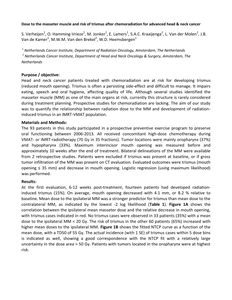Abstract Background: We studied the relationship between trismus (maximum interincisor opening [MIO] ≤35 mm) and the dose to the ipsilateral masseter muscle (iMM) and ipsilateral medial pterygoid muscle (iMPM). Methods: Pretreatment and post-treatment measurement of MIO at 13 weeks revealed 17% of trismus cases in 83 patients treated with chemoradiation and intensity-modulated radiation therapy. Logistic regression models were fitted with dose parameters of the iMM and iMPM and baseline MIO (bMIO). A risk classification tree was generated to obtain optimal cut-off values and risk groups. Results: Dose levels of iMM and iMPM were highly correlated due to proximity. Both iMPM and iMM dose parameters were predictive for trismus, especially mean dose and intermediate dose volume parameters. Adding bMIO, significantly improved Normal Tissue Complication Probability (NTCP) models. Optimal cutoffs were 58 Gy (mean dose iMPM), 22 Gy (mean dose iMM) and 46 mm (bMIO). Conclusions: Both iMPM and iMM doses, as well as bMIO, are clinically relevant parameters for trismus prediction.
DOCUMENT

Chest imaging plays a pivotal role in screening and monitoring patients, and various predictive artificial intelligence (AI) models have been developed in support of this. However, little is known about the effect of decreasing the radiation dose and, thus, image quality on AI performance. This study aims to design a low-dose simulation and evaluate the effect of this simulation on the performance of CNNs in plain chest radiography. Seven pathology labels and corresponding images from Medical Information Mart for Intensive Care datasets were used to train AI models at two spatial resolutions. These 14 models were tested using the original images, 50% and 75% low-dose simulations. We compared the area under the receiver operator characteristic (AUROC) of the original images and both simulations using DeLong testing. The average absolute change in AUROC related to simulated dose reduction for both resolutions was <0.005, and none exceeded a change of 0.014. Of the 28 test sets, 6 were significantly different. An assessment of predictions, performed through the splitting of the data by gender and patient positioning, showed a similar trend. The effect of simulated dose reductions on CNN performance, although significant in 6 of 28 cases, has minimal clinical impact. The effect of patient positioning exceeds that of dose reduction.
LINK
Purpose / objective: Head and neck cancer patients treated with chemoradiation are at risk for developing trismus (reduced mouth opening). Trismus is often a persisting side-effect and difficult to manage. It impairs eating, speech and oral hygiene, affecting quality of life. Although several studies identified the masseter muscle (MM) as one of the main organs at risk, currently this structure is rarely considered during treatment planning. Prospective studies for chemoradiation are lacking. The aim of our study was to quantify the relationship between radiation dose to the MM and development of radiation-induced trismus in an IMRT-VMAT population. Results: At the first evaluation, 6-12 weeks post-treatment, fourteen patients had developed radiation-induced trismus (15%). On average, mouth opening decreased with 4.1 mm, or 8.2 % relative to baseline. Mean dose to the ipsilateral MM was a stronger predictor for trismus than mean dose to the contralateral MM, as indicated by the lowest -2 log likelihood (Table 1). Figure 1A shows the correlation between the ipsilateral mean masseter dose and the relative decrease in mouth opening, with trismus cases indicated in red. No trismus cases were observed in 33 patients (35%) with a mean dose to the ipsilateral MM < 20 Gy. The risk of trismus in the other 60 patients (65%) increased with higher mean doses to the ipsilateral MM. Figure 1B shows the fitted NTCP curve as a function of the mean dose, with a TD50 of 55 Gy. The actual incidence (with 1 SE) of trismus cases within 5 dose bins is indicated as well, showing a good correspondence with the NTCP fit with a relatively large uncertainty in the dose area > 50 Gy. Patients with tumors located in the oropharynx were at highest risk.
DOCUMENT
